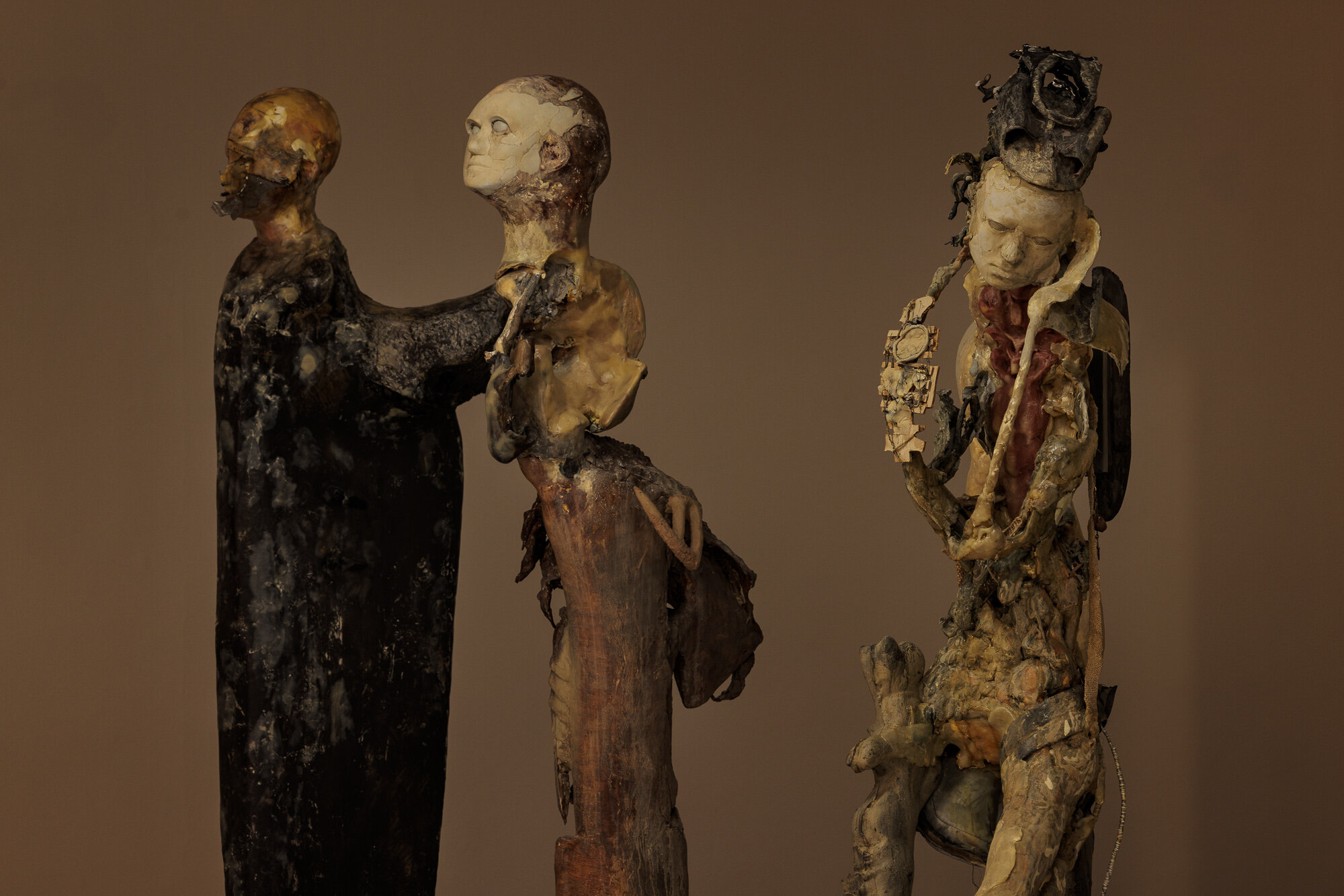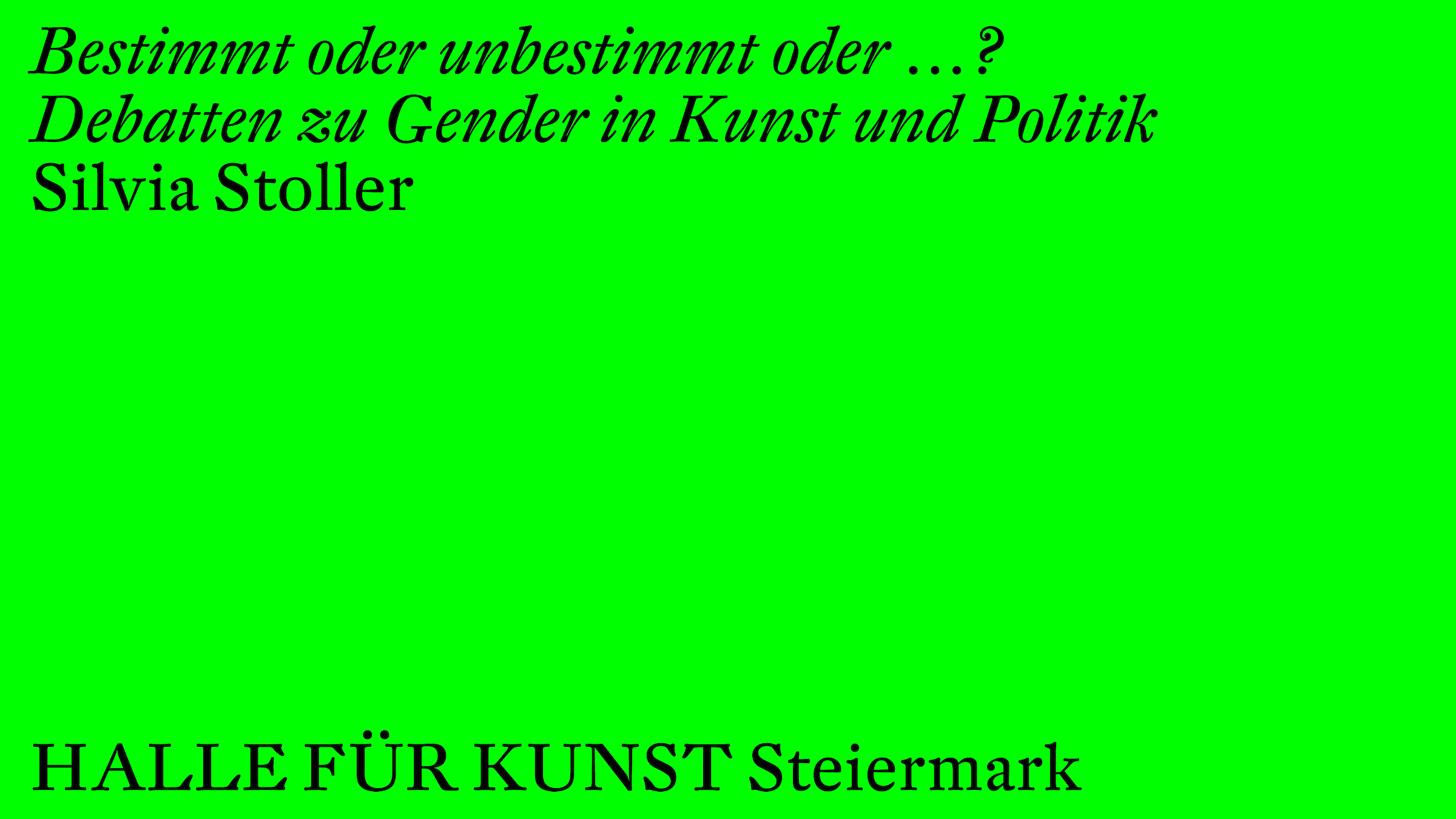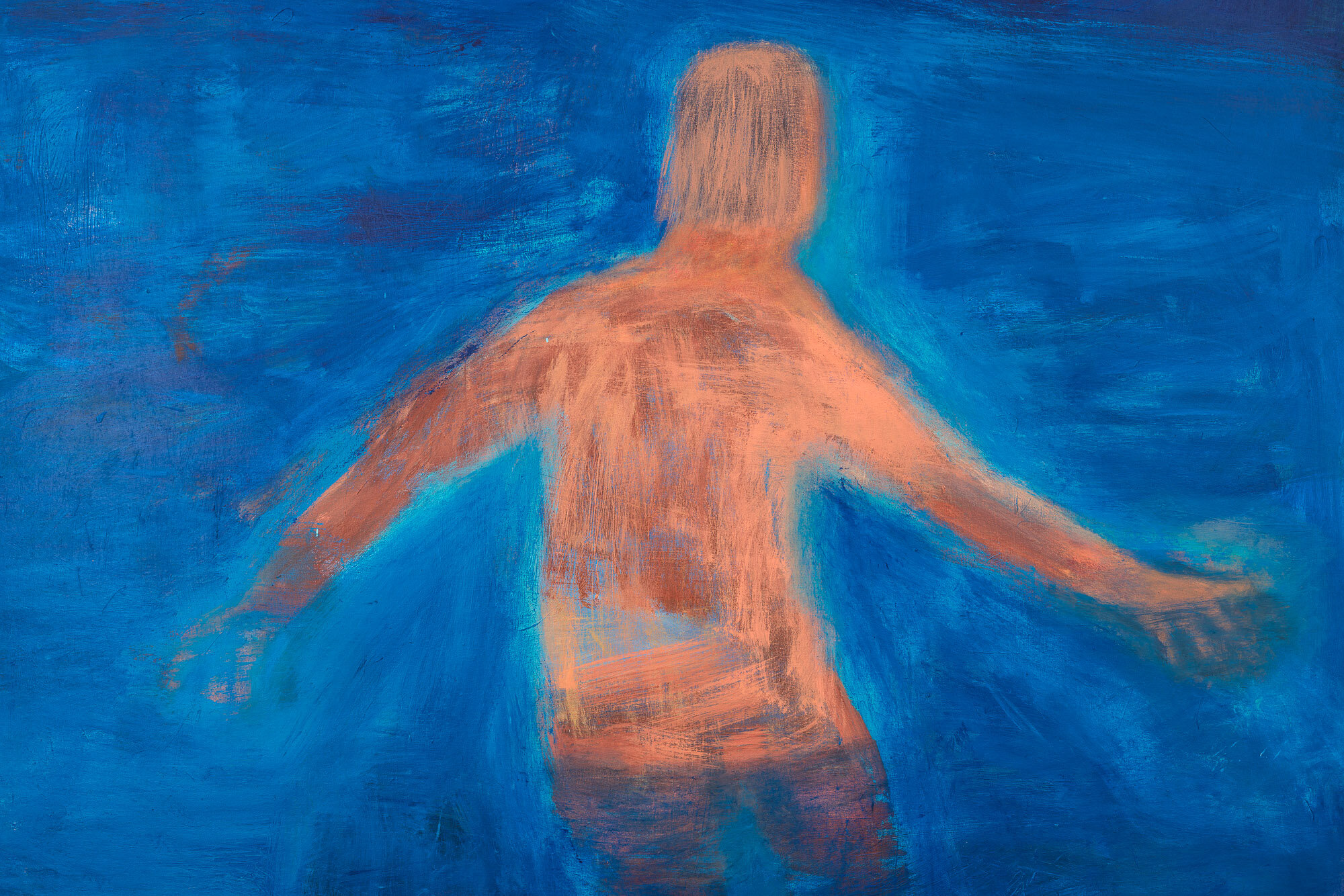TARWUK: Бољи живоt
by Kristian Vistrup Madsen
Essay

TARWUK Бољи живоt, 2023
Ausstellungsansicht, HALLE FÜR KUNST Steiermark, Graz
Foto: kunst-dokumentation.com
There’s a breath of resurrection in the air, murder transformed into a state of grace. (1)
Three figures in a line, on a stage, a confrontation with the monstrosity of selfhood breaking out of its confines; selfhood confronted with itself. They are skinless and towering. One, like the sharp sternpost of a ship, a black monolith. At once structure and ornament, they posit an idea of de-creation or post-formation; of the self in movement, its choreography of birth and decay. Or how about un-creation, with un- not as negation, but, as in Freud, return? If design, in many languages, is called ‘form-giving’, this is what comes after: taking form away. We could speak of transcendence, a dangerous game of playing God. And yes, these figures do represent a type of miracle. Ecstatic bodies, fantasies of wide-openness, of fluidity, of death-as-life and vice versa. They take your breath away.
When I first experienced TARWUK’s work at the Collezione Maramotti in 2021, the same sculptures were arranged in a series of seemingly consecutive scenes, each distinguished by their own ground, their own relationship to the wall, or to an object (a mirror, a chair, a flower, a prayerbook). Like traces of a familiar journey, this suggestion of narrative – ‘hooks in the real world’, as I wrote in a review of the exhibition – seemed to function as ‘buoys for the viewer’. But ‘what would happen’, I wondered:
if the bare bodies existed in the space without framing? Does their weird vivacity, their dense auratic power, depend somehow on this establishment of difference between figure and ground? Is it what makes them appear at all, or what enables us to approach them unwarily? (2)
As it turns out, the narrative parts are entirely movable. In Graz, the figures have all gathered in a line in the middle of the room. There is no longer a sense of sequence, or time passing, but rather a dense situation of time dammed up. A cache of information, stored and reorganised. But in Graz, too, there is framing – this remains, it seems, non-negotiable. A single large stage plays host to the sculptures, gathers and contains them under a set of six white Bauhaus lamps (another ‘hook in the real world’, a disturbance, a glitch). The stage is the Master of the room; we follow their lead. The figures, in turn, do not offer themselves to us; like archaic sculpture, they exist for themselves. And what becomes clear in this second iteration is that, as a framing device, the stage is not ‚what enables us to approach them unwarily’, but the opposite: a power move, an electric fence. It alienates, lets fall apart in the same instance as it holds.
Love, psychoanalysis, and the collapse of a nation state – these are three vantage points from which subjectivity, existence, life can come to look this way: arbitrary, vulnerable, unstable – deranged. TARWUK’s work addresses all three of these situations simultaneously and interchangeably. And it addresses at the same time as it simply is.
Being in love, or falling there, as we say, causes subjectivity to unravel. Love is an abyss. What you fall into is the other person as well as something unknown that belongs to neither of you. A much more recent, particular and, crucially, self-chosen construction is what we might call the psychoanalytic situation, especially the aspect of it known as transference. Janet Malcolm, in her book The Impossible Profession, ties together these two vantage points when she cites the analyst Hans Loewald, writing in 1927:
It cannot be too unusual for patients – I certainly remember it from the time I was a patient on the couch – to experience, at least at times, being in analysis as an illness, in so far as it is a regressive and unsettling experience, not dissimilar to the passions and conflict stirred up a new in the state of being in love which, from the point of view of the ordinary order and emotional tenor and discipline of life, feels like an illness, with all its deliciousness and pain. (3)
(Watch these latter two adjectives dart straight to the bittersweet heart encountering TARWUK’s work.) The third vantage point is both more rare and more common. Common because it happens, not just, as with lovers, to two people at a time, but to everyone around you all at once. Like analysis, especially as Lacan devised it, or love, which Roland Barthes called a ‘deranged discourse’, this third situation – extremely violent, material, physical, as it is also bound to be – is also a language situation. That is, a situation in which something that, on a material, physical level existed yesterday, and continues to exist, materially, physically tomorrow, from one moment to the next, has disappeared. This is what happened, for instance, in the countries of the former Soviet Union and the former Yugoslavia, to which millions of people had belonged until, one day, they didn’t anymore. These two words, now amputated, use ‘former’ as their protheses in the same way that the figures in this exhibition are also never purely themselves.
To be exposed to such a language situation and how it tugs at the rug under what you thought you knew as subjectivity, existence, life – perhaps especially in the latter case, when it is not only your private language that unravels, but a whole system – never really leaves you. Love is a scar as analysis, famously, is not treatment but labour. Any idea of the identity of a place or person will always, henceforth, be followed by a question-mark, inflected with a hint of irony, a sly smile, a glimmer in the white of your eyes. A space develops inside such a self, like a stage, which has both width and depth, and from which the lover’s discourse resounds, calling for the suspension of disbelief.
The stage as a space of unravelling is somewhat at odds with the idea of it as Master and ’power move’. This contradiction doubles another one, also inherent to TARWUK’s work, between emotional generosity – what we might call the ‘drama’ of their art – and a stubborn opacity, a stoic restraint. It is a problem familiar from psychoanalysis. In Malcolm, “Aaron Green”, her fictive, composite analyst, debunks the ‘popular myth about analysis that it makes the patient a clearer thinker, that it makes him wise and good’:
Analysis isn’t intellectual. It isn’t moral. It isn’t educational. It’s an operation. It rearranges things inside the mind in the way surgery rearranges things inside the body – even the way an automobile mechanic rearranges things under the hood of a car. It’s that impersonal and that radical. (4)
TARWUK rearrange their objects with the icy steadiness of a surgeon. Radically, impersonally transforming murder. Still, desire is a key ingredient here in a way that it certainly was for Freud, too, but cannot be for the surgeon. The nudity of TARWUK’s figures extends from their already exposed surfaces to their environments, like exhumed interiors. It is the type of porn where a camera travels through a person’s intestines because the viewer wants to go closer, closer, closer, see more, more, more, using the pretensions of science to promulgate mystery – we marvel at the strangeness, the darkness of our own insides.
But desire is key also because the objects gathered here breathe a dangerous, transgressive kind of intimacy. We might ask of them, as of Dennis Cooper’s 1989 novel Closer: closer to what? Cooper’s George Myles Cycle (1989−2000), of which Closer is the first volume, is about a boundless and radical form of desire, the beauty of youth and of death. George Mylesis someone for whom all drive is death drive, and Cooper’s long funeral song to George’s mutilated body is his declaration of love, the shrine that he builds for him. Closer ends with George having his rectum cut open with a surgeon’s scalpel as part of a sex act. He stumbles out into the street, a bloody mass, closer than ever. These are the kinds of images TARWUK’s work bring to mind; images of an unbearable, unimaginable kind of beauty, murder transformed into a state of grace.
‘If the “I” is the only thing we truly own, we must destroy it. Use the “I” to break down “I”,’ the philosopher Simone Weil writes in Gravity and Grace. Chris Kraus adds: ‘Weil wants to lose herself in order to be larger than herself… emotion is a current that dissolves the boundaries of a person’s subjectivity. It is a country. Shouldn’t it be possible to leave the body? Is it wrong to even try?’ (5) Let’s remember that war is born not from a fantasy of destruction but precisely its opposite – of order. If emotion is a country then the disappearance of a country is, too. There is peace in the dissolution of boundaries – love.
And so desire, yes, and Freud, sure, but more so love because this work – TARWUK’s – like Cooper’s and Weil’s, is about intra‑, inter- and extra- subjectivity; about losing one’s bearings and finding them outside of one’s body, sometimes, but not always, in another person’s hands. Love is exoskeleton – a real wound and a language situation. The sculptures arescraps of life assembled as if by force of nature and with love as its glue. Sentences escape from out of books like flies from out of slumber and stick to this glue, these bodies:
Nevada TV are doing a special programme on freeway prostitution. Into the microphone they ask: What are you proudest of, Sherry? Love is a hard job, she says, loving is the hardest thing I’ve done in my entire life. (6)
In A Lover’s Discourse, Barthes describes the impossibility of drawing the androgynous, primordial body, before it was split in two: ‘I cannot give this figure a form, at most I might conjure a monstrous, grotesque body.’ (7) In a sense, this is the appalling body to which the lover – unwillingly, desperately – returns. Barthes writes: ‘sorrow and joy befall me without causing any ravage: no tumour, I am dissolved, not broken, I fall, I float, I melt.’ (8) TARWUK’s work begins from this place. It does not budge, its language cannot be parsed, and yet I understand.
Words are never deranged, Bathes also writes. It is the syntax that is deranged. Madness arises when the subject cannot find its place in the sentence, or is forced into the wrong place. Love’s language, like that of the schizophrenic (at least in the popular imagination) consists of verbal hallucinations, imagined phrases, mutilated sentences, limited to their syntactic parts: ‘Even if you are… if you should still…’. (9) Neither questions nor assertions, but pure unadulterated expression, it addresses at the same time as it simply is.
Language in TARWUK’s work is similarly used as a type of hallucination. The golden text that lines the walls of the exhibition like a meander in Graz is written part in Cyrillic part in Latin script. Regardless, only fellow Croatians and every one from former Yugoslavia will understand that this is the first line of the title song to a TV series that ran on Yugoslav TV during the transformative years from 1987 – 1991. The show, called Better Life [Bolji život], was presumably about what such a life might be like and how to get it. I imagine that it did not, could not, provide an answer. (As Freud wrote, psychoanalysis might at best transform ‘your hysterical misery into common unhappiness’. (10)) Their name, TARWUK, too, means nothing, but looks like it might, or has people speculating that it does. Their titles are the same. Unruly and senseless, they function like the stage the sculptures stand on, as a power move that presses an unwelcome fact upon us, namely that some things cannot be known, but only intuited. Coming to terms with that is like staring into an abyss. This is exactly what TARWUK ask us to do.
What follows once you get over the vertigo is fairly obvious: you enjoy the view. What follows – in the next room – is a moment of intense concentration in the meeting with a large painting. Quiet. Integrated into the wall, it turns its back to the assemblage in the other room, like an altarpiece facing the rounding of the ambulatory rather than the congregation. If the objects on the stage have the quality of language situation, prosthesis, deranged syntax, here is the total eclipse of the boundary between language and reality. A good master must bare their own bones, too; image becomes architecture, speech acquires a body. The painting, like the sculptures, is produced by all four hands of TARWUK indistinguishably. It contains the meeting of two faces incased inside an amulet. Patterns and figures in ochre, lavender and aquamarine swirl with abandon, seeming to dissolve in the same instance as they form. There is a dense sense of calm in the painting, of for- middle and background collapsed into one, as if the drama of closeness enacted on stage has strangely and silently resolved. The monstrosity of ‘the additional’, that sharp pang of distance and difference between figure and ground, is folded inside a great mass like an object disappearing into clear, still lake. You want to disappear into this painting, and half expect the painting, in its turn, to disappear back into the wall. An emotion too big for this world, a country that never existed, gone. Shouldn’t it be possible to leave the body? Is it wrong to even try?
Notes
[1] Fleur Jaeggy, Sweet Days of Discipline (1989), trans. Tim Parks, (London: And Other Stories, 1991), p. 71.
[2] Kristian Vistrup Madsen, ‘Views: TARWUK at Collezione Maramotti’ in Spike issue 70, winter 2022.
[3] Janet Malcolm, Psychoanalysis: The Impossible Profession (1983), (London: Granta, 2018), p. 127.
[4] Malcolm, p. 107 – 8.
[5] Chris Kraus, Aliens and Anorexia, (Cambridge, MA: Semiotext(e), 2000), pp. 50 and 120.
[6] Augustín Fernández Mallo, Nocilla Trilogy (2006), (London: Fitzcarraldo, 2022), p. 19.
[7] Roland Barthes, Kærlighedens Forrykte Tale (Fragments d’un discours amoureux, 1977), trans. Karen Nicolajsen, (Copenhagen: forlaget politisk revy, 2002), p. 83. My translation from Danish.
[8] Barthes, p. 15.
[9] Barthes, p. 10.
[10] Malcolm, p. 27. She quotes Freud’s Studies on Hysteria.
Künstler:innen
Teilnehmende Künstler:innen
Kristian Vistrup Madsen
lebt als Autor in Berlin. Doing Time: Essays on Using People wurde 2021 bei Floating Opera Press veröffentlicht.







